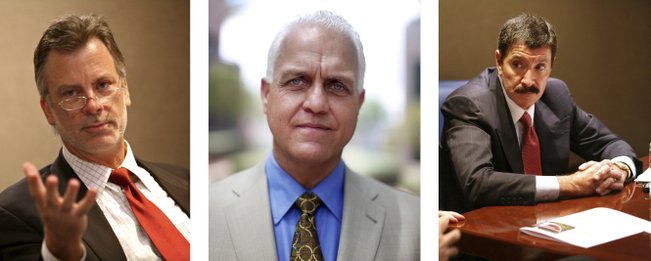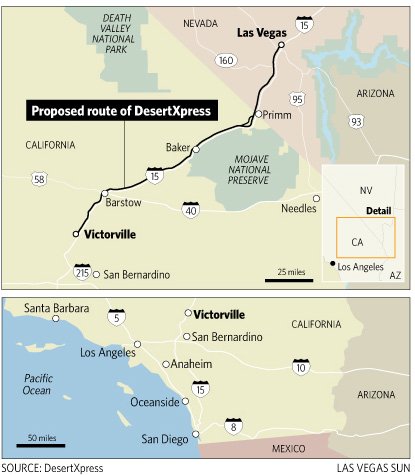Link: Maglev train to press on without Reid - Las Vegas Sun
Maglev train to press on without Reid
Planners ‘moving ahead’ despite senator’s defection to rival project
Image
Tiffany Brown
Organizers of a maglev train system linking Las Vegas and Southern California say they are undeterred by the loss of Sen. Harry Reid’s support. From left are Neil Cummings, American Magline Group president; transportation consultant Kevin Coates; and Bruce Aguilera, chairman of a maglev train commission.
By Lisa Mascaro (contact)
Wed, Jun 10, 2009 (2 a.m.)
Washington — Senate Majority Leader Harry Reid’s decision to support construction of a conventional high-speed rail link to California is just a “bump in the road,” promoters of the rival maglev rail line said Tuesday. They vowed to push ahead on a proposal that has existed for years on, if anything, optimism.
Reid’s office disclosed Tuesday that he had thrown his support to the DesertXpress high-speed rail link between Las Vegas and Victorville, Calif. For years, Reid had been a major supporter of a competing proposal to build a magnetic levitation train between Las Vegas and Anaheim.
The privately backed DesertXpress is just months away from seeking financing from Wall Street, its backers say. Reid’s support will help in that effort, and with attempts to gain federal funding and low-interest government loans to aid in construction.
According to DesertXpress estimates, the cost of linking Las Vegas to Victorville would be $4 billion, or one-third the cost of building a maglev line from Las Vegas to Anaheim.
The Obama administration has committed to invest an unprecedented $8 billion in high-speed rail nationwide as part of a federal economic recovery package. The guidelines for applying for money will be released next week.
Organizers of the maglev project are requesting $1.8 billion to build the first leg, a 40-mile path from Las Vegas to the state line at Primm, and to plan the rest of the route.
Bruce Aguilera, a casino executive of the Bellagio and chairman of the California-Nevada Super Speed Train Commission, told the Las Vegas Sun editorial board Tuesday that the maglev group will press forward, seeking support from allies in the White House.
“We’re moving ahead,” agreed Neil Cummings, president of the American Magline Group, the consortium that would build the line. He said backers would complete a required environmental review of the proposed link “and get it built.”
Cummings thinks the two projects can coexist. He said existing rights of way along the I-15 corridor to Southern California provide enough room for tracks for both trains.
The maglev train had been seen as such a front-runner that when Reid shepherded the recovery package through Congress this year, critics denounced the increased rail funds as pork for Nevada. They derisively called the maglev train Sin City Express.
But the DesertXpress project had been quietly gaining traction as a privately funded, lower-cost alternative. DesertXpress is backed by political mogul Sig Rogich, among the Republicans in Nevada who have announced their support for Reid’s reelection.
Aguilera said of Rogich, “He’s got clout. He’s got the ear of a lot of people. He’s been helpful for the DesertXpress, no doubt about it.
Aguilera said he understood Reid has been frustrated with the pace of progress on maglev, noting the senator is up for reelection next year. “He wants to get something done for Nevada and the voters.”
Neither project is ideal.
For all the allure of 300 mph maglev trains, the technology remains controversial among rail enthusiasts and is untried in this country.
Likewise, the main criticism of DesertXpress is its map: The train would run only as far as Victorville, a high-desert outpost more than an hour’s drive north of the Southern California basin.
Last year, Reid sought an independent assessment from the Government Accountability Office that compares systems the world over. A Reid spokesman said Tuesday that after “weighing the two, this is where he landed.”
The senator thinks DesertXpress is much closer to reality and he became less interested in the maglev project because of its heavy reliance on public funding, spokesman Jon Summers said.
DesertXpress has “made more progress in the last couple of years than maglev has made in the past 30,” Summers said. “He wants to see something done.”
Reid’s position was a shift from just last year, when he helped secure $45 million in federal funding for planning the maglev route — money that remains largely untouched because the maglev group has only recently secured necessary matching funds.
At that time, Reid scoffed at a private train whose route to Las Vegas would begin 85 miles northeast of downtown Los Angeles. Reid questioned whether visitors would drive through L.A. traffic to take a train the last 200 miles to Vegas.
“If it’s going to be really done in a big way, a Las Vegas way, the magnetic levitation would be the way to do it,” Reid said at the time. “If we can get this done, it will be the showboat of the world.”
More recently, Reid had been agnostic on the technology, saying he supports whatever line can be completed first.
Tom Stone, an executive with DesertXpress, saw immediate value in the senator’s position.
“We’re pleased the project has gained momentum, no question,” Stone said.
Since the president signed the recovery bill into law in February, Reid has been in contact multiple times with President Barack Obama and Transportation Secretary Ray LaHood about the importance of establishing a high-speed route between Las Vegas and Southern California.
Already, 10 high-speed rail corridors established during the Clinton administration are eligible for a portion of recovery money. These corridors connect major cities across the United States.
Reid has talked to both Obama and LaHood about establishing a Las Vegas-Southern California route as a corridor. The Transportation secretary has the authority under existing law to designate an 11th corridor.
Maglev supporters, who met recently with LaHood, have sought a corridor designation specifically for the Vegas-to-Anaheim route.



No comments:
Post a Comment